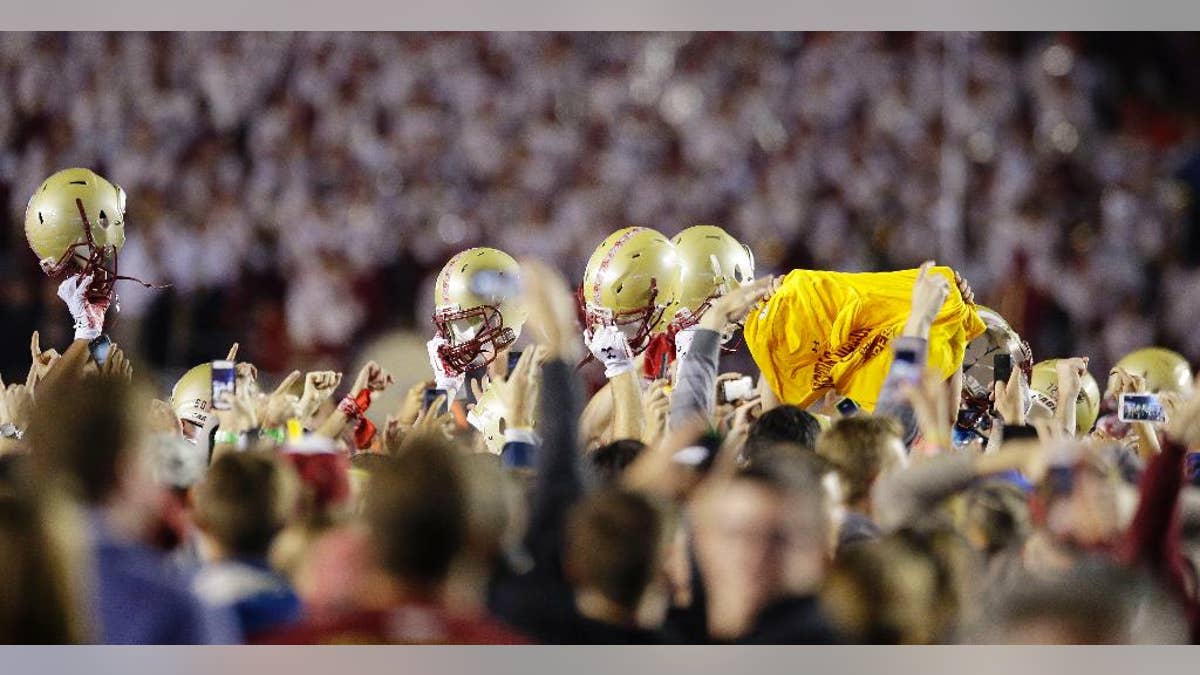
Repeated sub-concussion head impacts may affect eye function
By ,
Published May 19, 2016

Celebrating members of the Boston College team, holding their helmets above their heads, are surrounded by celebrating fans after they defeated Southern California in their NCAA college football game Saturday, Sept. 13, 2014 in Boston. Boston College defeated USC 37-3. (AP Photo/Stephan Savoia) (The Associated Press)
For U.S. college football players, head impacts that don't cause concussion symptoms do still cause subtle and lingering changes in the eyes' ability to focus, according to a new study.
The results might provide a new tool for measuring the severity of the "sub-concussive" brain impacts that athletes and others, like soldiers, experience regularly, researchers say.
"We believe that it is possible that there may be long-term effects, but we have no conclusive evidence currently," said lead author Dianne Langford of Temple University in Philadelphia.
"The changes are not clinically significant and in our study they resolved after three weeks of rest," Langford told Reuters Health by email.
The researchers studied 29 Division I football players who volunteered to wear special mouthguards during four full-contact practices and one noncontact preseason practice in August of 2015. The mouthguards contained electronics that measured the number and magnitude of head impacts for each player.
The players also had eye exams before each practice began and after the season was over.
The 29 players in the study experienced a total of nearly 1,200 sub-concussive head impacts over the five football practices, and researchers divided players into low- and high-impact groups based on how many hits they had taken.
Only seven players were in the low-impact group based on having between 6 and 16 total head impacts. The rest, designated high-impact players, each experienced between 41 and 96 hits to the head.
There was no difference in the types or frequency of physical symptoms reported by players in either group, the study team reports in JAMA Ophthalmology.
But researchers found that players in the high-impact group had gradual increases throughout the season in the "near point of convergence" of their eyes, which is the closest point at which the two eyes can view something clearly before double-vision occurs. The changes plateaued after a while, and then resolved by three weeks postseason.
Players in the low-impact group did not experience any changes in near point of convergence.
"Any type of impact in a contact sport like football is going to be common, however the significance of these impacts whether individually or aggregate remains unknown," said Dr. Andrew G. Lee of the Blanton Eye Institute at Houston Methodist Hospital in Texas, who coauthored an editorial accompanying the new findings.
"Subconcussive injuries are subclinical and are thus either under diagnosed or untreated," Lee said in an email.
Their long-term health effects, and even the significance of short-term changes in eye function, are unknown, he added.
Athletes with the most head impacts during the season may also have been getting the most exercise and the least rest compared to other athletes, which could have affected their eye function as well, the editorial notes.
But, Lee said, "we need to balance our legitimate concerns for safety against the benefits and joys of the sport. Individual players and their families need to make a risk-benefit decision as with any decisions in life."
Improving helmet design and reducing unnecessary head trauma might reduce the incidence of disease, Lee added.
"I can't say that (players) should be concerned at this point, but they should definitely be aware that these changes occur," Langford said. "Anyone who is concerned about these results should speak with their neurologist, ophthalmologist or other physician."
https://www.foxnews.com/health/repeated-sub-concussion-head-impacts-may-affect-eye-function